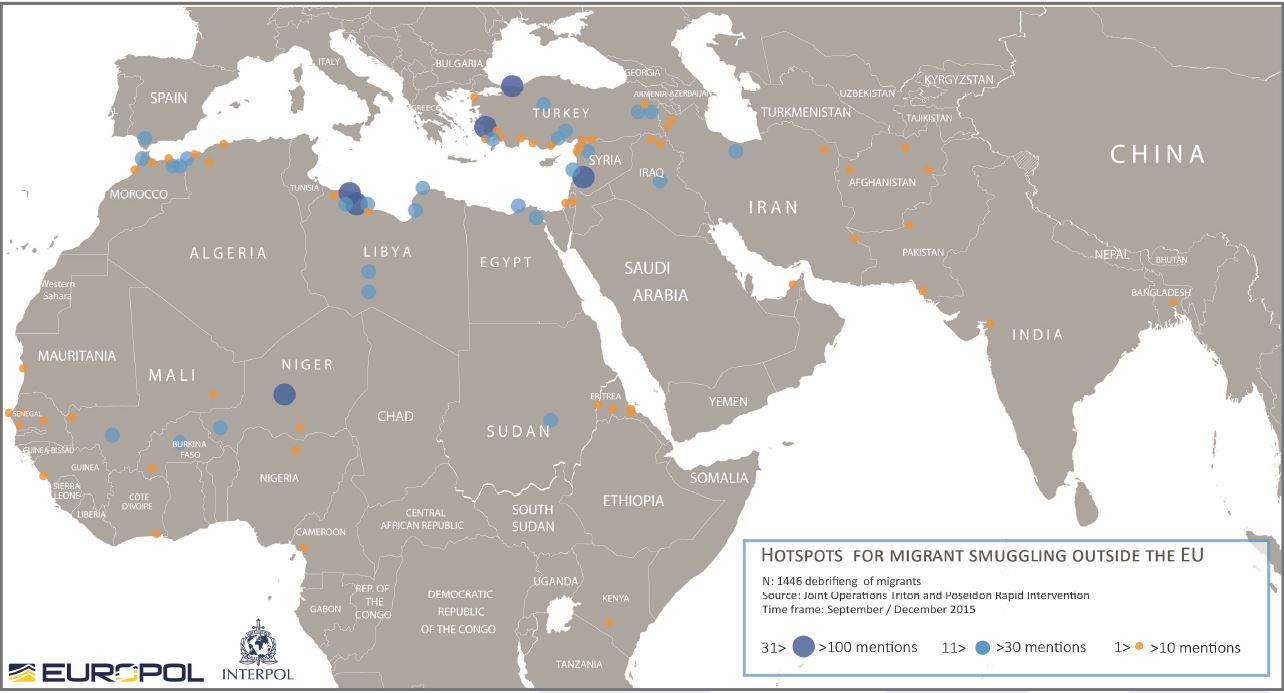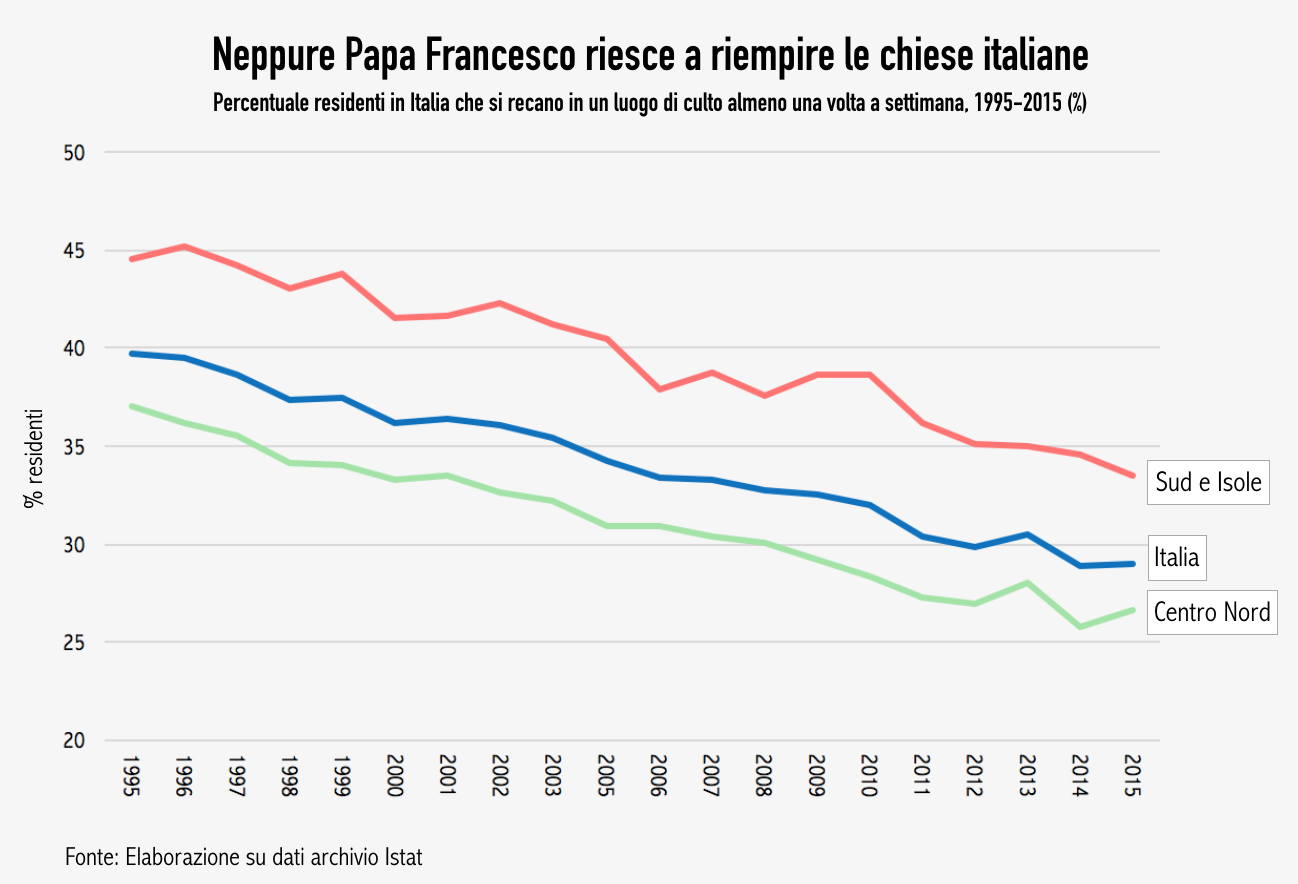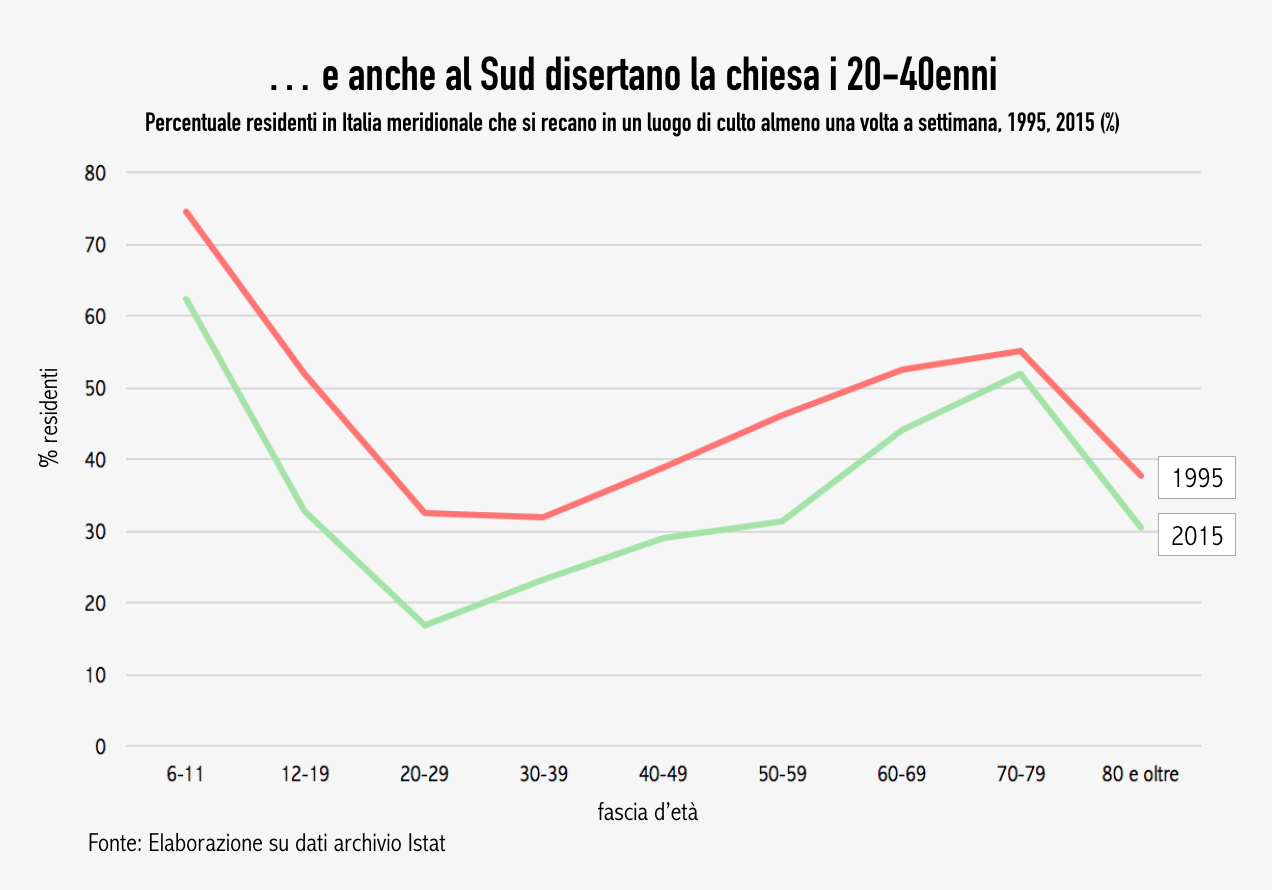“Wie laufen die Dinge?” Riccardo, ein alter Bekannter, Betriebswirt und Steuerberater, seufzt. “Nichts geht. Alle warten, was passiert".
“Niemand will etwas riskieren. Die Wirtschaft, soweit sie die Krise überlebt hat, stagniert. Die Leute sind unsicher. Man weiss nicht, was kommt, und da jeder irgendein Problem hat, ein Skelett im Schrank, macht er so wenig Wind wie möglich. Nicht auffallen, nicht investieren, einfach weitermachen, das ist die Stimmung".
Die Unsicherheit in Italiens Wirtschaft ist spürbar. Vieles hat sich geändert, seit Matteo Renzi am Ruder ist, und noch mehr wird sich ändern, das erwartet man. Aber was sich ändern wird und wie, das weiss man nicht. Deshalb hält man den Atem an und versucht, auf Unverhofftes vorbereitet zu sein. Arbeitsgesetzgebung, Bankenpleite, Korruptionsbekämpfung, Staatsverschuldung und das Damoklesschwert Zins, das über Italien hängt und unter dem Namen spread zurückkehren wird, sobald Draghi nicht mehr für Italien kämpft – viele beunruhigende Faktoren. Noch läuft alles irgendwie – aber wie lange?
Das Vertrauen in Renzis Staatskunst ist begrenzt, aber man weiss, dass grauenvoll werden kann, was nach ihm kommt. Die Irren von Beppe Grillos Alternativpartei vielleicht, die gerade Rom erobern und die am liebsten das Parlament durch Volksabstimmungen im Internet ersetzen würden. Oder die Rechten der Nordliga zusammen mit den Rechtsauslegern Fratelli d'Italia, den “Brüdern Italiens”, die auf Brüssel und Flüchtlingsschiffe am liebsten mit scharfer Munition schiessen würden.
Die Steuern: Volksfeind Nummer Eins ist die Vollstreckungsagentur Equitalia. Eine dem Fiskus nachgeschaltete Agentur, deren Aufgabe es ist, jene Steuerschulden einzutreiben, um die das Finanzamt seit Jahren vergeblich kämpft. Mit Überraschung lernten die Sünder, dass es nicht mehr reicht, guten Willen zu demonstrieren, sondern dass man tatsächlich zahlen muss, samt Strafe und Säumniszuschlägen. Zahllose Firmen, deren Geschäftsmodell sich nur bei Steuervermeidung rechnete, mussten aufgeben, viele Unternehmer gingen bankrott und etliche flüchteten in den Selbstmord.
Kein Wunder, dass Equitalia unter schweren Beschuss kam, zumal auch da Unregelmässigkeiten auftauchten. Der Gipfel der Empörung wurde mutmasslich erreicht, als Premier Renzi in Tokio weilte, seine Frau Agnese ihn anrief und ihm mitteilte, dass Equitalia ihm einen Bussbescheid über 2000 Euro für einen nicht bezahlten Park-Strafzettel geschickt habe. Renzi erklärte, er wolle als eine der kommenden Massnahmen Equitalia schliessen. Aber was dann?
Überhaupt erinnert die Regierung Renzi immer mehr an die Berlusconi-Epoche. Man verschiebt unpopuläre Entscheidungen, man verwässert Reformen, man schimpft auf Brüssel und die Deutschen, man redet seine kleinen Erfolge gross. Immer wieder erschüttern Skandale, an denen Mitglieder der Renzi-Partei beteiligt sind, das Reform-Image. Renzis eigener Vater, ein Unternehmer, ist nicht der Saubermann, den der Sohn gerne hätte. Und die Partei? Im Verein mit den Gewerkschaften kämpft der linke Flügel der Demokraten mehr gegen die Regierung als für sie.
Es ist fast ein Wunder, dass Renzi im täglichen Kleinkrieg mit den eigenen Leuten, ihren Durchstechereien und Intrigen, noch Zeit für die grossen Probleme findet. Seine Popularitätswerte sind im Abschwung; die laufenden Kommunalwahlen bringen wenig Gutes.
Und zu alledem die Flüchtlinge. Zu Tausenden kommen sie wieder an. Die Österreicher und Franzosen mauern, drohen, die Grenzen zu schliessen. Die Italiener aber werden nervös. Sie sehen sich in der Falle, allein gelassen mit einer Lawine von Immigranten, weit überwiegend aus Afrika.
“Schiffe von einem Dutzend Länder fischen die Migranten auf. Wo bringen sie sie hin? Zu uns. Warum zu uns? Wenn ein norwegisches Schiff eine Bootsladung aufnimmt, warum laden sie die bei uns ab? Ein norwegisches Schiff ist extra-territoriales Gebiet. Die Geretten befinden sich rechtlich in Norwegen und sollten nach Norwegen gebracht werden, nicht zu uns.” So argumentiert Teresa, eine Geschäftsfrau.
“Das ganze Flüchtlingstheater ist doch nur ein Geschäft. Da werden Milliarden umgesetzt. Die falschen freiwilligen Helfer werden doch in Wirklichkeit bezahlt, vom Staat und von Brüssel. Diese dutzende von Nichtregierungs-Organisationen” (in Italien Onlus genannt) "verdienen an dem Flüchtlingsgeschäft. Deswegen kommen die vielen Migranten ins Land".
Die deutsche AFD wäre vermutlich begeistert, wenn sie Teresa hören könnte. “Es hilft nichts. Renzi muss weg".
Da zeigt sich des Pudels Kern: das Flüchtlingsproblem ist für Italiens Rechte ein willkommener Hebel um die Linke samt Renzi aus dem Amt zu bugsieren. Das ohnehin rechts gestimmte Bürgertum nimmt die von Berlusconi-Fernsehen und rechten Zeitungen angebotene Darstellung der Flüchtlingskrise gierig auf und hofft, dass das bevorstehende Boots-Chaos im Sommer und Herbst der Regierung den Gnadenstoss geben wird.
So sieht sich Italien unter einem dunklen Wolkenhimmel. Eine Ahnung drohenden Unheils liegt über dem Land, das bereits durch Krisenjahre erschöpft ist und sich dennoch gezwungen sieht, den ineffizienten und korrupten Staat mit immer höheren Steuern und Abgaben zu füttern.
Der Wirtschaftsminister Pier Carlo Padoan, die Gewerkschaften und die meisten Politiker fordern Investitionen statt Austerity um die Wirtschaft zu beleben. Aber niemand investiert, denn weder die Ausländer noch die Italiener trauen diesem Staat und dieser Wirtschaft. Statt zu investieren, haben die Italiener in den Krisenjahren ihr Geld zusammen gehalten, haben gespart um Krisenverluste auszugleichen und ein Pölsterchen für kommendes Ungemach anzusammeln.
Derweil hat zumindest ein Sektor die Krise überwunden und expandiert wieder: die organisierte Kriminalität. Inzwischen auch in Norditalien fest installiert – vor allem in der Lombardei, in Ligurien und der Emilia-Romagna – geniessen 'Ndrangheta, Camorra und Cosa Nostra die relative Straflosigkeit einer Zeit, in der die Römer Regierung sich bemüht, grosse Umwälzungen gegen den Widerstand der traditionellen Politik und der Regionen durchzusetzen. Eine Art Interregnum, das das Gewaltmonopol des Staates und seine Durchsetzungsfähigkeit behindert.
Irritiert stellen Beobachter fest, dass grosse wirtschaftliche Entscheidungen zunehmend nicht mehr in Mailand oder Turin, sondern in obskuren Dörfern Kalabriens getroffen werden, wo die Bosse sitzen und von der Bevölkerung vor dem Staat geschützt werden. “Ohne die 'Ndrangheta geht nichts mehr in der Lombardei”, sagt man in Mailand.
Kein Wunder, dass die Mafias sich begeistert des Geschäfts mit den Flüchtlingen und Migranten angenommen haben und mit Hotspots und Ankunftszentren die reichlich fliessenden Staatsgelder abschöpfen. Auch was die Dschihad-Krieger angeht, zeigen die Camorra Kampaniens und die 'Ndrangheta Kalabriens keine Berührungsängste, leisten Hilfs- und Fälscherdienste im Austausch gegen Drogen.
Ausserdem sind die Migranten aus Afrika äusserst nützlich für das mafiöse Caporalato, das Leiharbeiter-System, das die italienische Landwirtschaft mit 400.000 straff organisierten Arbeitskräften zu weniger als 2.50 Euro Lohn pro Stunde versorgt. Ohne die Caporali und ihre in mehr als 80 Agrardistrikten des Südens und Nordens ohne Sozialversicherung mit Antibiotika statt Gesundheits-Betreuung schuftenden Italienerinnen, Afrikaner, Rumänen, Bulgaren und Araber wäre Italiens Agrarwunder nicht denkbar, das anstelle der lahmenden Industrie die Wirtschaft derzeit über Wasser hält.
All das ist bekannt: die wachsende Macht der Cosche, der Mafiasippen, im industriellen Norden und der Caporali vor allem im Süden. Nichts Durchgreifendes passiert, während die Regierung um die grösste Verfassungsreform seit 1945 bangt. Der Preis: der Süden verarmt und versinkt in Arbeitslosigkeit. Was immer schon schlecht war im Mezzogiorno wird noch schlechter, hoffnungsloser: ein griechischer Trend, wenn man so will. Doch auch im Norden breitet sich Resignation aus. Erst gestern sagte mir Sergio, ein Geschäftsmann aus Turin, des ehemaligen Industriezentrums Italiens: “In Turin kann man wunderbar leben. Alles ist billig, die Immobilienwerte sind abgestürzt: für 50, 40.000 Euro bekommt man ein Appartement. Nur eins kann man nicht in Turin: Arbeit finden. Geld verdienen ist unmöglich”.
Benedikt Brenner
Update
11 Millionen Italiener gehen nicht zum Arzt oder ins Krankenhaus, weil ihnen das Geld dafür fehlt, wie CENSIS berichtet. Seit 2012 ist die Zahl derer, die sich keine Behandlung leisten können, von 9 auf 11 Millionen gestiegen, grossteils alte Menschen und mittellose Jugendliche ("Millennials"). Die privaten Gesundheitsausgaben der Italiener sind um 3 auf 34,5 Milliarden Euro oder doppelt so schnell wie der gesamte Verbrauch gestiegen. Von den Personen, die Privatbehandlung suchten, taten das 73 Prozent aus Verzweiflung über die langen Wartezeiten bei der öffentlichen Kassenversorgung.






